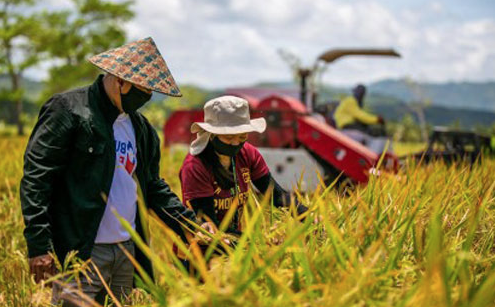
As more areas are planted to quality hybrid and inbred rice varieties with optimum levels of fertilizer application, attaining self-sufficiency in the country’s main staple is within reach.
Agriculture Secretary William D. Dar said that during the last three years of the Duterte administration, the Department of Agriculture (DA) has successfully implemented the Philippine Integrated Rice Program (PIRD) that saw a substantial increase in both the hectarage and average yield per hectare of both hybrid and inbred rice.
“Spanning six plantings, from wet season (WS) 2019 to dry season (DS) 2021-2022, we produced more rice from hybrids and inbreds, as area planted to hybrids peaked at 1.26 million (M) hectares (ha) in WS 2021 and DS 2021-2022, and 2.89 M ha for inbreds in WS 2019 and 2019-2020 DS,” said the DA chief.
“Further, the average yield of hybrids during the three-year period increased to 5.47 MT/ha during the wet season and 6.12 MT/ha during the dry season, which were 18.8% and 30.6% more compared to the average harvest of inbreds, during the six previous planting seasons,” Secretary Dar added.
Area planted to hybrid rice increased from 1 M ha during the 2019 WS and 2019–2020 DS, and then to 1.02 M ha in 2020 WS and 2020–2021 DS, and finally to 1.33M ha in 2021 WS and 2021-2022 DS.
For the recently concluded 2021-2022 DS, area planted to hybrids amounted to 697,630 ha, producing a total of 4.2 MMT, for a 6 MT/ ha average yield; while for inbreds, harvested area amounted to 867,226 ha with a total output of 3.9 MMT for a 4.5-MT/ha average.
“What is notable is that farmers are now producing more harvests and therefore earning bigger incomes from hybrid and inbred rice,” said Secretary Dar.
“This is evident among farmers in Nueva Ecija, where they attained the highest average yield in both hybrids and inbreds, at 7.67 MT/ha and 6.45 MT/ha, respectively, compared to farmers in 14 other provinces where the DA implements the PIRP,” said the DA chief.
The PIRP features three components, namely: the Rice Competitiveness Enhancement Fund (RCEF), National Rice Program (NRP) that includes hybrid promotion, and Rice Resiliency Project (RRP) that grants fertilizer subsidies to inbred and hybrid rice farmers.
Of the 15 provinces, the top 10 hybrid rice producers in terms of volume during 2021-2022 DS were: Nueva Ecija (1 MMT); followed by Isabela (660,943 MT); Cagayan (623,082 MT); Tarlac (328,621 MT); Pangasinan (231,995 MT); Leyte (176,781 MT); Oriental Mindoro (147,928 MT); Iloilo (137,067 MT); Camarines Sur (128,514 MT); and Occidental Mindoro (116,122 MT).
In terms of average yield of hybrid per hectare (MT/ha), Nueva Ecija is followed by: Ilocos Norte (6.78), Occidental Mindoro (6.51), Cagayan (6.21), Tarlac (6.01), and Isabela (6.00 MT/ha).
“In all, to sustainably increase palay production and attain rice self-sufficiency, our farmers should continuously plant quality hybrid and inbred seeds, apply the optimum amount of fertilizers following a balanced fertilization strategy, and couple their efforts with science-based technologies and innovations, and modern machinery and equipment. This way, and with assured budgetary support, we could produce palay at a cost-efficient manner, reducing our current production cost from P11 down to about P9 to P8 per kilo, and attain reasonably-priced rice for consumers,” concluded Secretary Dar. ###














